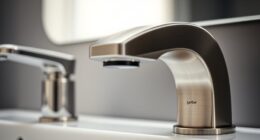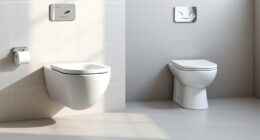When faced with a clogged bathtub, it is essential to find fast and efficient solutions. This article will delve into the typical causes and do-it-yourself techniques for unclogging a bathtub.
We will also discuss using natural ingredients and tools to tackle stubborn clogs. Knowing when to seek professional help is crucial, and we’ll provide guidance on that too.
Get ready to master the art of keeping your bathtub drain flowing smoothly. Let’s dive in!
Key Takeaways
- Common causes of bathtub clogs include hair and debris getting trapped in the drain, lack of a drain cover, failure to regularly clean the drain cover, and not using a drain strainer or filter.
- DIY methods to unclog a bathtub include plunging with a plunger, using a mixture of baking soda and vinegar, using a drain snake to dislodge clogs, and pouring boiling water down the drain.
- Natural ingredients such as baking soda and vinegar, salt and boiling water can be used to clear bathtub drains, avoiding harsh chemicals and allowing natural ingredients to break down debris and buildup.
- When DIY methods are not effective, it is important to seek professional help for persistently clogged bathtubs to ensure proper resolution of the clog, prevention of further damage, and to save time, effort, and potentially long-term costs.
Common Causes of Bathtub Clogs
One of the main reasons why bathtubs become clogged is because hair and debris get trapped in the drain. To prevent bathtub clogs, it’s important to take certain preventive measures.

Firstly, installing a drain cover can catch hair and prevent it from going down the drain. Regularly cleaning the drain cover and removing any trapped hair or debris is also crucial.
Additionally, it’s advisable to use a drain strainer or filter to catch any larger particles before they enter the drain. To maintain a clean and clog-free bathtub, regular cleaning is essential.
Using a bathtub cleaner and scrubbing the surfaces can help remove any buildup and prevent clogs. Regularly flushing the drain with hot water can also help prevent blockages. By following these prevention tips and maintaining a clean bathtub, you can avoid the hassle of dealing with clogs.
Now, let’s move on to the next section where we’ll discuss DIY methods to unclog a bathtub.

DIY Methods to Unclog a Bathtub
To unclog a bathtub, we can try a few DIY methods that are simple and effective. It’s important to address the issue as soon as possible to prevent further damage and inconvenience. There are several signs that indicate a clogged bathtub, such as slow drainage, standing water, or unpleasant odors. By following these bathtub clog prevention tips, you can reduce the chances of a clog occurring in the first place. Regularly clean the drain and remove any hair or debris that may accumulate. Additionally, using a drain strainer can help prevent larger items from going down the drain. If you do find yourself dealing with a clogged bathtub, try these DIY methods to unclog it:
| Method | Materials Needed | Steps |
|---|---|---|
| Plunger | Plunger | 1. Fill the tub with enough water to cover the plunger. 2. Place the plunger over the drain and vigorously plunge up and down for several minutes. 3. Repeat if necessary. |
| Baking Soda and Vinegar | Baking soda, vinegar, boiling water | 1. Pour 1/2 cup of baking soda down the drain. 2. Follow with 1/2 cup of vinegar. 3. Let the mixture sit for 15 minutes. 4. Pour boiling water down the drain. |
| Drain Snake | Drain snake | 1. Insert the drain snake into the drain until you feel resistance. 2. Rotate the snake to dislodge any clogs. 3. Pull out the snake and remove any debris. |
These DIY methods can be effective in unclogging a bathtub and restoring proper drainage. However, if the clog persists or if you are unsure about handling the situation yourself, it is best to seek professional assistance.
Using Natural Ingredients to Clear Bathtub Drains
We recommend using natural ingredients for clearing bathtub drains. When faced with a clogged drain, there are a few effective methods you can try that don’t involve harsh chemicals. Here are three natural solutions to consider:
- Baking soda and vinegar solution: Start by pouring half a cup of baking soda down the drain, followed by half a cup of vinegar. Let the mixture sit for about 30 minutes to allow it to break down any debris or buildup. Finally, flush the drain with hot water to clear away the loosened material.
- Salt and boiling water method: Begin by pouring half a cup of salt down the drain. Follow this with a kettle full of boiling water. The combination of salt and hot water can help dissolve grease and other substances that may be causing the clog.
Remember to use these methods with caution and always follow proper safety measures. By using these natural ingredients, you can effectively clear your bathtub drain without resorting to harsh chemicals.

Tools and Techniques for Removing Stubborn Clogs
Now let’s explore the tools and techniques that can effectively remove stubborn clogs in your bathtub drain.
When faced with a stubborn clog, two main methods can be employed: plunging techniques and chemical drain cleaners.
Plunging is a tried and tested method that utilizes the force of water pressure to dislodge the clog. To plunge effectively, ensure a tight seal between the plunger and the drain, and then vigorously push and pull to create suction. Repeat this motion several times until the clog is cleared.
Chemical drain cleaners, on the other hand, can be a powerful solution for stubborn clogs. These cleaners contain strong chemicals that break down the clog, allowing it to be washed away. However, it’s essential to follow the instructions carefully and use protective gear, as these cleaners can be corrosive. It’s also worth noting that chemical drain cleaners should be used sparingly, as they can damage pipes with repeated use.

When to Seek Professional Help for a Clogged Bathtub
It is advisable to consider professional assistance when faced with a persistently clogged bathtub. While there are many DIY methods to unclog a bathtub, certain situations may require the expertise of a professional plumber.
Here are some signs of a serious clog that indicate the need for professional help:
- Slow draining: If your bathtub is draining slower than usual, it could be a sign of a more significant clog deeper in the pipes.
- Multiple clogged drains: If you notice that other drains in your home, such as sinks or toilets, are also clogged, it may indicate a larger issue with your plumbing system.
- Recurring clogs: If you frequently experience clogs in your bathtub despite attempting DIY methods, it’s time to seek professional assistance.
When deciding whether to hire a professional plumber, it’s essential to consider the potential cost. While the cost of hiring a professional may be higher initially, it can save you time, effort, and money in the long run by ensuring that the clog is properly resolved and preventing further damage to your plumbing system.
Frequently Asked Questions
How Much Does It Cost to Hire a Professional Plumber to Unclog a Bathtub?
When the bathtub is clogged, the cost to hire a professional plumber for unclogging can vary. However, it’s worth considering cost comparisons and DIY alternatives before making a decision.

Can a Clogged Bathtub Drain Lead to Other Plumbing Issues in the House?
A clogged bathtub drain can cause decreased water pressure throughout the house, as well as potential damage to the sewage system. It is important to address this issue promptly to avoid further plumbing complications.
Are There Any Long-Term Solutions to Prevent Bathtub Clogs From Occurring?
To prevent bathtub clogs, we must be proactive in maintaining our drains. Regularly cleaning and using drain covers can help prevent blockages. Taking these precautions will ensure smooth draining and avoid future plumbing issues.
Can Using Chemical Drain Cleaners Damage the Bathtub or Pipes?
Using chemical drain cleaners can potentially damage both the bathtub and pipes. However, there are alternative methods for unclogging a bathtub that are effective and safer. It is important to consider the pros and cons before making a decision.
What Should I Do if None of the DIY Methods or Natural Ingredients Are Effective in Unclogging My Bathtub?
When to call for professional help when the DIY methods fail? We should consider hiring professionals if none of the DIY methods or natural ingredients prove effective in unclogging our bathtub.

Conclusion
So next time you find yourself dealing with a clogged bathtub, don’t panic! With a little DIY know-how and some handy natural ingredients, you can tackle most bathtub clogs on your own.
And if all else fails, there’s always the option of calling in the professionals. Remember, a clogged bathtub is just a temporary inconvenience, and with the right tools and techniques, you’ll have that drain flowing freely in no time.
Happy unclogging!










